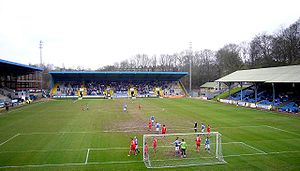The Shay
 |
|
| Full name | The Shay |
|---|---|
| Location | Shay Syke, Halifax, West Yorkshire, England, HX1 2YS |
| Coordinates | 53°42′58″N 1°51′33″W / 53.71611°N 1.85917°WCoordinates: 53°42′58″N 1°51′33″W / 53.71611°N 1.85917°W |
| Owner | Calderdale Metropolitan Council |
| Operator |
F.C. Halifax Town Halifax RL |
| Capacity | 14,061 (5,830 seated) |
| Surface | Grass |
| Construction | |
| Opened | 1921 |
| Architect | (East Stand Redesign) Ward Mchugh Associates |
| Tenants | |
|
Halifax Town (1921–2008) Halifax Dukes (1949–1952, 1965–1986) Halifax RL (1998–present) F.C. Halifax Town (2008–present), Huddersfield Giants (2011 – 3 games) |
|
The Shay (known as the MBi Shay due to sponsorship) is a sports stadium in Halifax, West Yorkshire, England. Halifax Town football and Halifax rugby league clubs both play home games at the Shay.
The stadium is owned by Calderdale Metropolitan Council and leased by the Shay Stadium Trust, a not-for-profit company set up to preserve the ground as a sports stadium.
The Shay lies on the south side of Halifax, about a quarter of a mile from the town centre. The four stands at the Shay are the North Stand, the East Stand, the South Stand and the Skircoat Stand. The North and South stands were built in the mid-1990s. The Skircoat Stand is the oldest stand at the Shay.
'Shay' is derived from the old English word 'shaw', which means a small wood, thicket or grove. The two words are used interchangeably in ancient references to the property upon which the stadium was eventually constructed.
Such references to the name Shay have been traced as far back as 1462, when on 6 July of that year a wealthy local man by the name of William Brodley recorded that upon his death, property belonging to him just west of Shaghe Lane should pass to his son, John Brodley. At the time of the third year of Henry VIII's reign (this means either 1511 or 1512), the Subsidy Roll (effectively the equivalent of our present income tax) had recorded William Brodley junior as being assessed on goods to the value of £20, and by 1545 the property was still in his possession. This may seem a small sum today but it's worth noting that only five people locally were assessed at £20 (including the wealthy Vicar Haldesworth who was once robbed of £1,000), so it's fair to say that William Brodley was a man of influence and money. Indeed, at this time, only one man was assessed at more than £20, and he was the wealthy merchant John Hardy who paid 44 shillings (£2.20) tax on goods assessed at £66. What this goes to prove is that the Shay Estate was one of the finest areas of 16th century Halifax. Just when William Brodley died is not clear but we do know that the Shay descended to his daughter and heiress Grace Hely in 1580, and in turn to her husband John Booth in 1587. This was recorded in the Halifax Court Rolls as Booth becoming the owner of 'Shaw and Nether Shaw'. At about this time, conservation of water and the maintenance of its purity were matters of extreme importance, and in 1588 John Booth arranged for a small dam to be constructed within the Shay Estate so as to provide enough water for his needs. This supply was later diverted away from the Shaw Syke in 1602 and within two years Booth surrendered ownership of 'Over and Nether Shaw' to the use of Simon Bynnes of Broadbottom. As there are no records of subsequent owners after Bynnes, or of the houses they would have lived in, this gives us the opportunity to jump forward to the 18th century to introduce the name of perhaps the Shay's most noted owner – John Caygill.
...
Wikipedia
